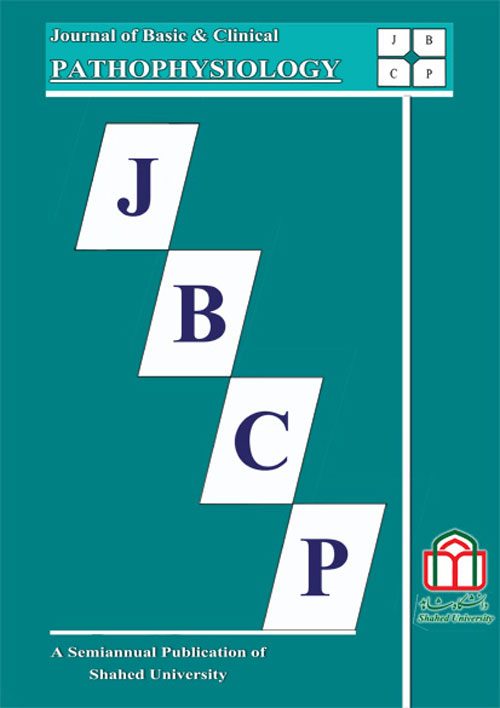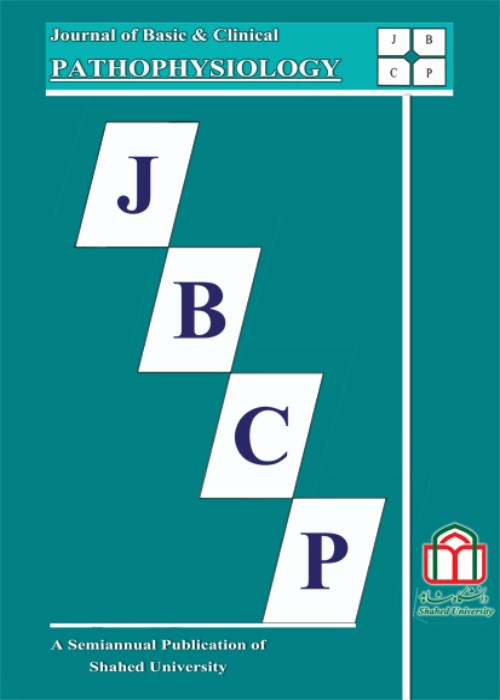فهرست مطالب

Journal of Basic & Clinical Pathophysiology
Volume:5 Issue: 2, Summer-Autumn 2017
- تاریخ انتشار: 1396/08/06
- تعداد عناوین: 7
-
-
Pages 1-8Background And ObjectiveThe purpose of this study was to investigate the preconditioning effect of aerobic exercise with vitamin D3 consumption on vascular endothelial growth factor (VEGF) level in the 6-hydroxydopamine (6-OHDA)-lesioned rat model of Parkinsons disease.Materials And MethodsForty-eight male rats weighing 250-300 g were randomly assigned to 6 groups: healthy control, Parkinsons control, sham, exercise-Parkinsons, vitamin-Parkinsons, and vitamin笗ꭲ⬞Parkinsons groups. The exercise groups exercised for 4 weeks, 5 days per week for 30 minutes on a treadmill at the speed of 15 m/min and with the slope of zero. The vitamin groups received vitamin D3 for 4 weeks, 2 days per week and at a dose of 1 mg/kg of body weight. After 4 weeks of exercising and taking the vitamin, an experimental model of Parkinson's disease was developed using stereotactic surgery and injection of 6-OHDA into the striatum. Three weeks later, apomorphine-induced rotational test was conducted in order to verify the parkinsonian condition in rats and then VEGF levels in the striatum were measured by ELISA method after the isolation and extraction of the striatum of the rats brain.ResultsThe results showed that four weeks of treadmill aerobic exercise in combination with vitamin D3 intake before 6-hydroxydopamine injection could significantly increase VEGF levels in the striatum (pConclusionThe results of this study demonstrated that preconditioning with aerobic exercise combined with D3 intake can increase the protection of dopaminergic neurons against 6-hydroxydopamine-induced damage by increasing the levels of VEGF and thus play a protective role against Parkinson's disease.Keywords: Aerobic exercise, vitamin D3, VEGF, 6-hydroxydopamine, Parkinson's disease
-
Pages 9-14Background And ObjectiveParkinsons disease (PD) is a chronic neurodegenerative disease characterized by damages to striatal dopaminergic neurons that affects 1 to 2% of the population above 65 years of age. Olive leaf extract (OLE) is a powerful antioxidant that is considered as a source of various phenolic compounds. This study was conducted to evaluate the effects of methanolic OLE on hippocampal antioxidant biomarkers in an animal model of PD.Materials And MethodsIntrastriatal 6-hydroxydopamine-lesioned rats were pretreated with OLE at doses of 50, 100 and 150 mg/kg/day for six weeks. At the end of treatment, the antioxidants activity in the hippocampal area was assayed.Results6-hydroxydopamineinduced oxidative stress significantly decreased activity of superoxide dismutase (SOD), glutathione peroxidase (GPX), glutathione reductase (GRX) and catalase (CAT) and treatment with OLE restored the activity of antioxidant enzymes SOD, GPX, GRX, and CAT and also decreased malondialdehyde (MDA) as an index of lipid peroxidation and increased glutathione (GSH) levels in the hippocampus.ConclusionThese results suggest that OLE pretreatment reduces hippocampal oxidative biomarkers in an animal model of PD.Keywords: Olive leaf extract, Parkinson's disease, 6-hydroxydopamine, Hippocampal oxidative stress
-
Pages 15-20Background And ObjectiveEpilepsy as a chronic neurological disorder causes inherent seizures and learning and memory failure. Since there is no acceptable control of seizures in some patients with the current recommended drug therapy, new medications with different mechanisms of action are needed. Here, the beneficial effect of hepatocyte growth factor (HGF) was evaluated in an experimental model of temporal lobe epilepsy in male rats.Materials And MethodsIn the present study, effects of intracerebroventricular administration of HGF (6 µg) thirty minutes before intrahippocampal injection of kainic acid (4 µg) on spontaneous seizures and learning and memory impairment were assessed in rats. As positive control group, valproic acid (200 mg/kg) was injected intraperitoneally.ResultsBehavior data showed that the kainate rats exhibited spontaneous seizures, lower spontaneous alternation score in Y-maze task (pConclusionThis study revealed that HGF administration to kainate-injected rats attenuates seizure scores and improves learning and memory.Keywords: Kainic acid, HGF, Passive avoidance, Y maze
-
Pages 21-26Background And ObjectiveIt is well known that stress and glucocorticoid, modulate memory processing, though the result is completely dependent on the time of stress induction. This study investigated the effect of acute corticosterone administration on memory retrieval of recent and remote memory in a 4 trials/day (low- intensity learning) or 8 trials/ day (high- intensity learning) Morris water maze protocol.Materials And MethodsSixty four adult male Wistar rats were used in this research study. Corticosterone was injected subcutaneously (3 mg/kg) 30 min before the probe trial test of Morris water maze. Control animals received the vehicle.ResultsAcute corticosterone, thirty minutes before probe test led to impairment of memory retrieval phase in recent (pConclusionApparently, learning enhancement was just effective for protecting deleterious effects of corticosterone in recent memory and had no effect on remote memory. Thus, acute stress may impair memory retrieval in a time-dependent manner.Keywords: Recent memory, Remote memory, Acute stress, Morris water maze
-
Pages 27-34Background And ObjectiveThe mental illnesses are one of the main problems in countries. Man has used medicinal herbs to control mental illnesses for centuries. This article reviews available effective sedative herbs that play a role in controlling mental illnesses.Materials And MethodsAt first, the authentic traditional texts and the Quran and the statements of the innocents were studied. Then, the keywords including mental disorders such as anxiety, depression, nerve restlessness, Parkinsons disease, melancholia, fear, nerve calming, psychosis and convulsion and other disorders, sedative herbs, medicinal herbs, the name of herbs and sedation were searched in PubMed and Google Scholar from 2014 to 2017. The more relevant articles were selected and the most effective tranquilizer herbs were studied.ResultsNearly 50 medicinal plants were found out to be effective in controlling mental illnesses. From the herb list, we selected the most effective ones. Including criteria for the selection of herbs was also the vast spectrum of effectiveness, harmless, and easy availability. Therefore, the 8 following plants had first priority: Borage officinalis, Lavandula angustifolia, Valeriana officials, Crocus sativa, Melissa Officinal, Hypericum perforatum, Passiflora incarnate, and Humulus upulus.ConclusionConsidering the effectiveness, harmlessness, and availability, the Crocus sativa should be used in foods in usual dosage and the other plants as herbal tea separately or in combination.Keywords: Herbs, Tranquilizer, Mental disorders
-
Pages 35-40Background And ObjectiveDiabetes mellitus (DM) affects synaptic plasticity in the hippocampus, leading to impairments in learning and memory. L-carnosine, an endogenous dipeptide, is reported to exhibit anti-diabetic and antioxidant effects. Therefore, this study was designed to evaluate its effect on learning and memory in diabetic rats.Materials And MethodsIn the present study, male Wistar rats (n=32) were randomly divided into four groups: control, control treated with carnosine (100 mg/kg), diabetic, and diabetic treated with carnosine (100 mg/kg). Diabetes was induced by streptozotocin (STZ) at a dose of 60 mg/kg. L-carnosine was injected i.p. at a dose of 100 mg/kg one week after STZ injection for 8 weeks. Blood sample was taken from retro-orbital plexus before STZ injection and 4 and 8 weeks after STZ injection to measure blood glucose level. Passive avoidance and Y maze tests were done to assess learning and memory deficits.ResultsAfter 8 weeks, diabetic rats showed a significant cognitive dysfunction in passive avoidance and Y maze tests that was significantly attenuated following carnosine treatment. In addition, carnosine showed a hypoglycemic effect.ConclusionThis study demonstrated that treatment with carnosine for 8 weeks could improve cognitive functions in diabetic condition and part of its beneficial effect is due to its reduction of blood glucose.Keywords: Diabetes mellitus, L-carnosine, Streptozotocin, Cognitive dysfunction, Memory
-
Pages 41-46Background And ObjectiveAlzheimers disease (AD) is a neurodegenerative disorder which is associated with extracellular accumulation of amyloid beta (Aβ) plaques. AD is accompanied by mitochondrial dysfunction and energy metabolism reduction. Fibroblast growth factor 21 (FGF21) is an endogenous polypeptide which its beneficial effects have been demonstrated on mitochondrial function, energy metabolism regulation and neuroprotection.Materials And MethodsThe present study was performed to investigate the effect of pretreatment with different concentrations of FGF21 [100,200 and 400 nM] on SH-SY5Y cells as a cellular model of AD induced by Ab(1-42). For induction of cellular model of AD. Ab(1-42) [20 µM] was added to SH-SY5Y cell medium. Cell viability (MTT assay) and mitochondrial membrane potential changes (Rhodamine 123 fluorescence intensity) were measured using microplate reader.ResultsThe results of this study showed that Ab(1-42) enhances cell damage (pConclusionTaken together, the results of this study suggest that FGF21 prevents cell death induced by Ab(1-42) in SH-SY5Y cells. It seems that the beneficial effects of FGF21 are mediated through mitochondrial membrane potential maintenance.Keywords: Amyloid beta, SH-SY 5Y cells, Cell viability, Mitochondrial membrane potential


